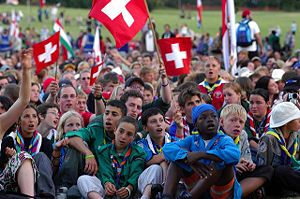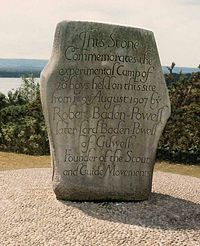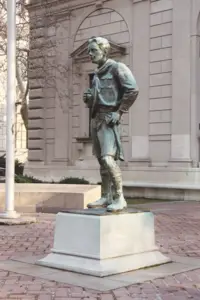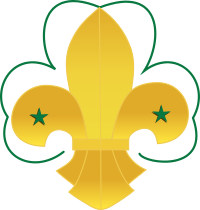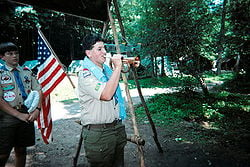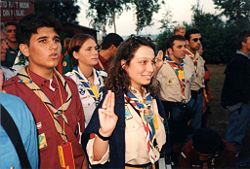A Boy Scout is a boy, usually a teenager, participating in the worldwide Scouting movement founded in 1908 by Robert Baden-Powell. A parallel movement for girls, Girl Guides (also called Girl Scouts) was introduced by Robert and his sister, Agnes Baden-Powell, in 1910. Boy Scouts are organized into troops averaging twenty to thirty Scouts under guidance of a Scout leader, and subdivided into patrols of about six Scouts. Troops may affiliate with national and international organizations. Some troops, especially in Europe, have been co-educational since the 1970s, allowing boys and girls to work together as Scouts.
Scouting organizations are run according to the Scout method, which is designed to instill character, citizenship, leadership, and personal fitness through a structured program of outdoor activities. The Scout motto "Be Prepared" is famous throughout the world, and millions of young people have benefited from the training, learning to become individuals of integrity able to work and relate well with others. Baden-Powell held the view that God was central to the Scouting method, although he did not demand adherence, nor allow discrimination, based on any particular faith.
History
Robert Baden-Powell founded the Boy Scouts as an organization in 1908, a few months after the first scout encampment at Brownsea Island Scout Camp in 1907.[1]
Origins
As a military officer, Baden-Powell was stationed in India and Africa in the 1880s and 1890s. Since his boyhood, he was fond of woodcraft and military scouting, and therefore ‚Äď as part of their training ‚Äď showed his men how to survive in the wilderness. He noticed it taught the soldiers to develop independence, rather than just blindly follow officers' orders.[2]
In South Africa in the Second Boer War, Baden-Powell was besieged in the small town Mafeking against a much larger Boer army (the Siege of Mafeking).[3] The Mafeking Cadet Corps was a group of youths that supported the troops by carrying messages, which freed the men for military duties and kept the boys occupied during the long siege. The Cadet Corps performed well, helping in the defense of the town (1899‚Äď1900), and were one of the many factors that inspired Baden-Powell to form the Scouting movement.[4][5] Each member received a badge that illustrated a combined compass point and spearhead. The badge's logo was similar to the fleur-de-lis that Scouting later adopted as its international symbol.
In the United Kingdom the public followed his struggle to hold Mafeking through newspapers, and when the siege was broken Baden-Powell had become a national hero. This pushed the sales of a small instruction book he had written about military scouting, Aids to Scouting. On his return to England he noticed the large interest of boys in this book, which was also used by teachers and youth organizations.
In July 1906, Ernest Thompson Seton sent Baden-Powell a copy of his book The Birchbark Roll of the Woodcraft Indians. Seton, a British-born Canadian living in the United States, met Baden-Powell in October 1906, and they shared ideas about youth training programs.[6][7] In 1907 Baden-Powell wrote a draft called Boy Patrols. In the same year, to test his ideas, he gathered 21 boys of mixed social backgrounds and held a week-long camp in August on Brownsea Island in Poole Harbour, Dorset, England.[1] His organizational method, now known as the Patrol System and a key part of Scouting training, allowed the boys to organize themselves into small groups with an elected patrol leader.[8]
In the autumn of 1907, Baden-Powell went on an extensive speaking tour arranged by his publisher, Cyril Arthur Pearson, to promote his forthcoming book, Scouting for Boys. He had not simply rewritten his Aids to Scouting, but left out the military aspects and transferred the techniques (mainly survival skills) to non-military heroes: backwoodsmen, explorers (and later on, sailors and airmen).[2] He also added innovative educational principles (the Scout method).
Scouting for Boys first appeared in England in January 1908 as six fortnightly installments, and was published in England later in 1908 in book form. The book became one of the bestselling titles of all time and is commonly considered the first version of the Boy Scout Handbook.
At the time, Baden-Powell intended that the scheme would be used by established organizations, in particular the Boys' Brigade, founded by William Alexander Smith.[9] However, because of the popularity of his person and the adventurous outdoor game he wrote about, boys spontaneously formed Scout patrols and flooded Baden-Powell with requests for assistance. He encouraged them, and the Scouting movement developed momentum.
Growth
The Boy Scout movement swiftly established itself throughout the British Empire soon after the publication of Scouting for Boys.
The program initially focused on boys aged 11 to 18, but as the movement grew, the need became apparent for leader training and programs for younger boys, older boys, and girls. Baden-Powell and his sister Agnes Baden-Powell introduced the Girl Guides in 1910, a parallel movement for girls, sometimes named Girl Scouts. Agnes Baden-Powell became the first president of the Girl Guides, at the request of the girls who attended the Crystal Palace Rally.
The first programs for Cub Scouts, and Rover Scouts were in place by the late 1910s. They operated independently until they obtained official recognition from their home country's Scouting organization. In the United States, attempts at Cub programs began in the 1910s, but official recognition was not obtained until 1930.[10] It was also evident that young girls wanted to participate in similar activities, but the Edwardian values at the time would not allow young boys and girls to "rough and tumble" together, causing the Girl Guides (later to be called Girl Scouts) to be created.
Baden-Powell could not single-handedly advise all groups who requested his assistance. Early Scoutmaster training camps were held in London in 1910 and in Yorkshire in 1911. Baden-Powell wanted the training to be as practical as possible to encourage other adults to take leadership roles, so the Wood Badge course was developed to recognize adult leadership training. The development of the training was delayed by World War I, and so the first Wood Badge course was not held until 1919.[11] Gilwell Park near London was purchased in 1919 on behalf of The Scout Association as an adult training site and Scouting campsite.[12] Baden-Powell wrote a book, Aids to Scoutmastership, to help Scouting Leaders, and wrote other handbooks for the use of the new Scouting sections, such as Cub Scouts and Girl Guides. One of these was Rovering to Success, written for Rover Scouts in 1922.
Expansion around the world
Following its foundation in the United Kingdom (UK), Scouting spread around the globe. The first recognized overseas unit was chartered in Gibraltar in 1908, followed quickly by a unit in Malta. Scouts Canada became the first overseas dominion with a sanctioned Boy Scout program, followed by Australia, New Zealand, and South Africa. Chile was the first country outside the British dominions to have a recognized Scouting program. By 1910, Argentina, Denmark, Finland, France, Germany, Greece, India, Malaya, Mexico, the Netherlands, Norway, Russia, Sweden, and the United States had Boy Scouts.[13] The first Scout rally, held in 1910 at The Crystal Palace in London, attracted 10,000 boys and a number of girls.
In most countries of the world, there is now at least one Scouting (or Guiding) organization. Each is independent, but international cooperation continues to be seen as part of the Scout Movement. In 1922, the World Organization of the Scout Movement (WOSM) started as the governing body on policy for the national Scouting organizations (then male only). In addition to being the governing policy body, it organizes the World Scout Jamboree every four years.[14]
In 1928, the WAGGGS started as the equivalent to WOSM for the then female-only national Scouting/Guiding organizations. It is also responsible for the various international centers such as Our Chalet.
Today at the international level, the two largest umbrella organizations are:
- World Organization of the Scout Movement (WOSM), for boys-only and co-educational organizations.
- World Association of Girl Guides and Girl Scouts (WAGGGS), primarily for girls-only organizations but also accepting co-educational organizations.
Influences

Important elements of traditional Scouting have their origins in Baden-Powell's experiences in education and military training. The name "Scouting" seems to have been inspired by the important and romantic role played by military scouts performing reconnaissance in the wars of the time. In fact, Baden-Powell wrote his original military training book, Aids To Scouting, because he saw the need for the improved training of British military-enlisted scouts, particularly in initiative, self-reliance, and observational skills. As he adapted the book as Scouting for Boys, it seems natural that the movement adopted the names Scouting and Boy Scouts.[15]
Aspects of Scouting practice have been criticized as too militaristic.[16] Military-style uniforms, badges of rank, flag ceremonies, and brass bands were commonly accepted in the early years because they were a part of normal society, but since then have diminished or been abandoned in both society and Scouting.
Local influences have also been a strong part of Scouting. By adopting and modifying local ideologies, Scouting has been able to find acceptance in a wide variety of cultures. In America, Scouting uses images drawn from the U.S. frontier experience. This includes not only its selection of animal badges for Cub Scouts, but the underlying assumption that American Indians are more closely connected with nature and therefore have special wilderness survival skills which can be used as part of the training program. By contrast, British Scouting makes use of imagery drawn from the Indian subcontinent, because that region was a significant focus in the early years of Scouting. Baden-Powell's personal experiences in India led him to adopt Rudyard Kipling's The Jungle Book as a major influence for the Cub Scouts; for example, the name used for the Cub Scout leader, Akela (whose name was also appropriated for the Webelos), is that of the leader of the wolf pack in the book.[17]
Over time, the Boy Scout program has been reviewed and updated in many of the countries where it is run, but the same core values and principles that Baden-Powell originally envisaged still apply.
Program
The Boy Scout program is designed to develop youths to have a high degree of self-reliance, initiative, courage, helpfulness, integrity, and resourcefulness. Boy Scouts should be helpful; understand their society, heritage, and culture; have respect for the rights of others; and be positive leader-citizens.[18][19]
The World Organization of the Scout Movement (WOSM) describes Scouting as "a voluntary non-political educational movement for young people open to all without distinction of gender, origin, race or creed, in accordance with the purpose, principles and method conceived by the Founder."[20] It is the goal of Scouting "to contribute to the development of young people in achieving their full physical, intellectual, social and spiritual potentials as individuals, as responsible citizens and as members of their local, national and international communities."[20]
Scout method
A Boy Scout learns the cornerstones of the Scout method, Scout Promise, and Scout Law. These are designed to instill character, citizenship, personal fitness, and leadership in boys through a structured program of outdoor activities.[20][21] Common ways to implement the Scout method include spending time together in small groups with shared experiences, rituals, and activities; as well as emphasizing good citizenship and decision-making that are age-level appropriate. Cultivating a love and appreciation of the outdoors and outdoor activities are key elements. Primary activities include camping, woodcraft, first aid, aquatics, hiking, and sports.
The principles of Scouting describe a code of behavior for all members, and characterize the movement. The Scout method is a progressive system designed to achieve these goals, comprising four elements:
- Scout Law and Scout Promise (Scout Oath)
- Learning by doing
- Development of small groups
- Progressive and attractive programs of different activities
The Scout Law and Oath embody the joint values of the Scouting movement worldwide, and bind all Scouting associations together. The emphasis on "learning by doing" provides experiences and hands-on orientation as a practical method of learning and building self-confidence. Small groups build unity, camaraderie, and a close-knit fraternal atmosphere. These experiences, along with an emphasis on trustworthiness and personal honor, help to develop responsibility, character, self-reliance, self-confidence, reliability, and readiness; which eventually lead to collaboration and leadership. A program with a variety of progressive and attractive activities expands a Scout's horizon and bonds the Scout even more to the group. Activities and games provide an enjoyable way to develop skills such as dexterity. In an outdoor setting, they also provide contact with the natural environment.[21]
Since the birth of Scouting, Scouts worldwide have taken a Scout Promise or Oath to live up to ideals of the movement, and subscribe to the Scout Law. The form of the promise and laws have varied slightly by country and over time, but must fulfill the requirements of the WOSM to qualify a National Scout Association for membership.
The Scout motto, "Be Prepared," is used in various languages by millions of Scouts throughout the world. Less well-known is the Scout Slogan, "Do a good turn daily."
Uniforms
The Scout uniform is a specific characteristic of Scouting. In the words of Lord Baden-Powell at the 5th World Scout Jamboree in 1937, it "hides all differences of social standing in a country and makes for equality; but, more important still, it covers differences of country and race and creed, and makes all feel that they are members with one another of the one great brotherhood."[22] The original uniform, which has created a familiar image in the public eye and had a very military appearance, consisted of a khaki button-up shirt, shorts, and a broad-brimmed campaign hat. Baden-Powell himself wore shorts as he felt that being dressed like the youth contributed to reducing distances between the adult and the young person.
Uniforms have become much more functional and colorful since the beginning and are now frequently blue, orange, red, or green, and shorts are replaced by long trousers in areas where the culture calls for modesty, and in winter weather. T-Shirts and other more casual wear have also replaced the more formal button-up uniforms in many Scouting regions.
To show the unity of all Scouts, the World Membership Badge (World Crest) is a part of all uniforms. Neckerchiefs and Woggles (slides) are still quite common, but some Scouting associations do not use them. Patches for leadership positions, ranks, special achievements, troop- or group- numbers or names, and country or regional affiliation are standard.
Working for ranks and merit badges
All Scouting organizations have an advancement program whereby the Scout learns scoutcraft, community service, and leadership and explores areas of interest to him at an increasingly difficult level. The lower ranks focus mostly on basic Scouting skills. Requirements for demonstrating leadership, community service, and learning about other topics, such as possible career areas, generally come in the middle and upper ranks. Scouts are recognized by being awarded ranks and badges of recognition, such as merit badges (also called proficiency badges). Merit badges are awarded for a variety of fields, such as mastering advanced scoutcraft, sports, aquatics, ecology, citizenship, and academics.[23]
All Scouting associations have a highest rank that require mastering scoutcraft, leadership, and performing community service. Only a small percentage of Scouts attain them. In the Scouting associations of many member states of the Commonwealth of Nations, the highest rank is the Queen's Scout or King's Scout Award. In the United States it is the Eagle Scout Award. Other worldwide Scouting groups include the Crown Scout (Belgium), Pramuka Garuda (Indonesia), King Scout (Thailand), and Chief Scout's Award (Canada).
As Scouts grow older they often seek more challenging and diverse activities. To meet this demand, programs such as Air Scouts, Sea Scouts, Rover Scouts, Venturing, and Exploring are established.
Fellowship
Camping most often occurs on a unit level, such as in the troop, but there are periodic "camporees" and "jamborees." Camporees are events where units from a local area camp together for a weekend. These occur a couple times a year and usually have a theme, such as pioneering. Jamborees are large events on a national or international level where thousands of Scouts camp together for one to two weeks. Activities at these events include games, scoutcraft competitions, Scouting memorabilia collecting, aquatics, woodcarving, archery, and rifle and shotgun shooting.
For many Scouts, the highlight of the year is spending at least a week in the summer as part of an outdoor activity. This can be a long event such as camping, hiking, sailing, canoing, or kayaking with the unit or a summer camp operated on a council, state, or provincial level. Scouts attending a summer camp, generally one week during the summer, work on merit badges, advancement, and perfecting scoutcraft skills. Some summer camps operate specialty programs for older Scouts, such as sailing, backpacking, canoing, whitewater kayaking, caving, and fishing.
Organization
Troop
The troop is the fundamental unit of the Boy Scouts. It is the group a Boy Scout joins, and via which he participates in Scouting activities, such as camping, backpacking, and canoeing. The troop leadership, youth and adult, organizes and provides support for these activities. A troop may include as few as a half-dozen boys, or as many as seventy or more, and usually meets weekly. A troop is often sponsored by a community organization such as a business, service organization, school, labor group, veteran's group, or religious institution. The chartering organization is responsible for providing a meeting place and promoting a good program.[24]
Patrol
Each troop is divided into patrols of six to ten Scouts and use the "patrol method," whereby the Scouts divide into smaller groups within the troop. A patrol's independence from the troop varies among troops and between activities.[25] Some troops mix older and younger Scouts in the same patrols, so that the older boys can teach the younger ones more effectively. Other troops group boys by age, and may assign an older boy as a "troop guide" to mentor each of the younger patrols.
Leadership in the troop
Every troop has two separate leadership structures: one consisting of Scouts and another consisting of adults. The adult leadership manages the logistics of troop activities, administers rank advancement and awards, maintains troop records and finance, and recruits new Scouts and adult leaders. The youth leadership keeps order and coordinates labor at activities. Scouts and adults cooperate to plan agendas for troop meetings, as well as the troop's schedule of outings.
A committee of adults, usually including parents of the Scouts, selects a chair and appoints its members to specific positions, most importantly those of the Scoutmaster and his assistants. These leaders must complete special training mandated by their Scouting association. The top level leader training course around the world is Wood Badge.[24]
The youth leadership is headed by a senior patrol leader (SPL), who works closely with the Scoutmaster to run troop activities. He is expected to attend most meetings and outings. While the SPL is directly responsible for running the troop, he shares that responsibility with one or more assistants (Assistant Senior Patrol Leaders or ASPLs). Other troop-wide positions of responsibility exist and their duties vary from country to country.[25]
The SPL is elected by the entire troop, from a list of candidates approved by the Scoutmaster. He then cooperates with the Scoutmaster to appoint the other troop-wide leaders. Likewise, each patrol elects a Patrol Leader (PL), who appoints his Assistant Patrol Leader(s) (APL). All youth leaders serve six-month terms.
Higher level organization
One or more troops can form a district. These troops in the district are generally located near each other geographically and provide mutual support, advice, and district level encampments several times per year. In some countries, this is the first level at which the troop has contact with professional Scouters from its association. Above this level is a national association, and most national associations are members of the World Organization of the Scout Movement (WOSM) and/or the World Association of Girl Guides and Girl Scouts (WAGGGS), although some are members of the Order of World Scouts, the World Federation of Independent Scouts, the International Union of the Guides and Scouts of Europe (UIGSE) or Confederation of European Scouts (CES) and others are non-aligned.
Age groups and sections
Scouting movements are generally divided into sections by age or school grade, allowing activities to be tailored to the maturity of the group's members. These age divisions have varied over time as they adapt to the local culture and environment.
Scouting was originally developed for adolescents‚ÄĒyouths between the ages of 11 and 17. In most member organizations, this age group composes the Boy Scout section. Programs were developed to meet the needs of young children (generally ages 6 to 10) and young adults (originally 18 and older, and later up to 25). Scouts were later split into "junior" and "senior" sections in many member organizations, and some organizations dropped the young adults' section. National programs for younger children include Tiger Cubs, Cub Scouts, Beaver Scouts, and Joey Scouts. Programs for post-adolescents and young adults include the Rover Scouts, Venture Scouts, Explorer Scouts, and the Scout Network. Many organizations also have a program for members with special needs, usually known as Extension Scouting or Scoutlink (UK). The Scout Method has been adapted to specific programs such as Air Scouts, Sea Scouts, Rider Guides, and Scouting bands.
Religion in scouting
Religion in Scouting and Guiding is an aspect of the Scout method which has been practiced differently and given different interpretations over the years. "Duty to God" is a principle of Scouting, though it is applied differently among countries.[26][27] The Boy Scouts of America (BSA) take a strong position, excluding atheists:
The Boy Scouts of America maintains that no member can grow into the best kind of citizen without recognizing an obligation to God. In the first part of the Scout Oath or Promise the member declares, ‚ÄúOn my honor I will do my best to do my duty to God and my country and to obey the Scout Law.‚ÄĚ The recognition of God as the ruling and leading power in the universe and the grateful acknowledgment of His favors and blessings are necessary to the best type of citizenship and are wholesome precepts in the education of the growing members. No matter what the religious faith of the members may be, this fundamental need of good citizenship should be kept before them. The Boy Scouts of America, therefore, recognizes the religious element in the training of the member, but it is absolutely nonsectarian in its attitude toward that religious training. Its policy is that the home and the organization or group with which the member is connected shall give definite attention to religious life.[28]
The Boy Scout Handbook says that "A Scout is Reverent" means that "A Scout is reverent towards God. He is faithful in his religious duties. He respects the beliefs of others." The BSA 2019 Guide to Advancement states:
From time to time, issues related to advancement call for an understanding of the position of the Boy Scouts of America on Christian religious principles. The Boy Scouts of America does not define what constitutes religious belief in a God or practice of religion. Neither does the BSA require membership in a religious organization or association for membership in the movement. If a Scout does not belong to a religious organization or association, then the Scout’s parent(s) or guardian(s) will be considered responsible for organizational religious training. All that is required is the acknowledgment of belief in a God as stated in the Declaration of Religious Principle and the Scout Oath, and the ability to be reverent as stated in the Scout Law.[29]
The United Kingdom Scout Association requires adult leaders to acknowledge a higher power, but does not necessarily exclude atheists from roles in Scouting, as long as the local Commissioner is satisfied that the applicant leader will support the values of Scouting and the investigation of faith by the young people in the movement. Canada defines Duty to God broadly in terms of "adherence to spiritual principles" and does not have a policy excluding non-theists.
Scouting organizations are free to interpret the method as laid down by the founder. As the modern world has become more secular and materialistic, and as many societies have become more religiously diverse, this has caused misunderstandings and controversies in some of the national member organizations.
Founder's views
When creating the Scouting method, Baden-Powell was adamant that there was a place for God within it. Indeed, the Scout Promise requires an incoming member to fulfill their "duty to God." In Scouting for Boys, Baden-Powell wrote specifically about Christianity, since he was writing for youth groups in the United Kingdom:
We aim for the practice of Christianity in their everyday life and dealings, and not merely the profession of theology on Sundays…[30]
However, the founder's position moved shortly after the Scout movement began to grow rapidly around the world, and his writings and speeches allowed for all religions. He did continue to emphasize that God was a part of a Scout's life:
When asked where religion came into Scouting and Guiding, Baden-Powell replied, It does not come in at all. It is already there. It is a fundamental factor underlying Scouting and Guiding.[26]
Though we hold no brief for any one form of belief over another, we see a way to helping all by carrying the same principle into practice as is now being employed in other branches of education…[27]
Baden-Powell's gravestone bears no cross or other religious symbol. Rather, in addition to the Boy Scout and Girl Guide Badges, it bears a circle with a dot in the center, the trail sign for "Going home" / "I have gone home": ![]() .[31]
.[31]
Interpretations
Religion and spirituality is still a key part of the Scouting method. The two major world organizations have slightly different interpretations.
The World Organization of the Scout Movement (WOSM) states the following:
Under the title "Duty to God," the first of the above-mentioned principles of the Scout Movement is defined as "adherence to spiritual principles, loyalty to the religion that expresses them and acceptance of the duties resulting therefrom." It should be noted that, by contrast to the title, the body of the text does not use the word "God," in order to make it clear that the clause also covers religions which are non-monotheistic, such as Hinduism, or those which do not recognize a personal God, such as Buddhism.[32]
National organizations may further define it. For instance, the Religious Policy of The Scout Association of the United Kingdom states that:
- "All Members of the Movement are encouraged to:
- make every effort to progress in the understanding and observance of the Promise to do their best to do their duty to God;
- belong to some religious body;
- carry into daily practice what they profess."[33]
- make every effort to progress in the understanding and observance of the Promise to do their best to do their duty to God;
Many Scout/Guide groups are supported by local religious bodies, including Christian, Islamic, Jewish and Sikh communities. These local groups often have a more strict interpretation on the original writings of Baden-Powell concerning religion. However, since they often belong to national organizations that are not of a specific religion, there are usually groups in the neighborhood that have a less strict interpretation. Additionally, some national organizations are aimed at the adherents of a specific religion, but there usually are other Scouting/Guiding organizations within that country that are more open or have a more neutral point of view concerning religion.
Some Scouting organizations have many obligatorily religious merit badges[34] or recognize religious programs run by another organizations, like the religious emblems programs in the United States, as a way of fulfilling a requirement for a rank. Other Scouting organizations have a single voluntary religious merit badge or none. Scouting organizations that do not allow the participation of atheists, agnostics, or homosexuals have been publicly criticized.
Co-educational
Worldwide there have been different approaches to co-educational Scouting. In the USA, separate Scouting organizations for boys and girls were maintained for many years. In 2018 the Boy Scouts of America permitted girls to join.[35]
In other countries, notably in Europe, Scouting and Guiding have merged, and there is a single organization for boys and girls, which is a member of both the WOSM and the WAGGGS. In others, for example Australia and the United Kingdom, the national Scout association has opted to admit both boys and girls, but is only a member of the WOSM, while the national Guide association has remained as a separate movement and member of the WAGGGS. In Slovenia, Spain, and Greece, it is the other way around, as the national Guide association has opted to admit both boys and girls, and the national Scout association has remained a separate movement.
The Scout Association of the United Kingdom has been co-educational at all levels since 1991, but this has been optional for groups. Since 2000, new sections were required to accept girls. The Scout Association decided that all Scout groups and sections should become co-educational by January 2007, the year of Scouting's centenary.
Notes
- ‚ÜĎ 1.0 1.1 Brian Woolgar and Sheila La Riviere, Why Brownsea? The Beginnings of Scouting (Brownsea Island Scout and Guide Management Committee, 2002).
- ‚ÜĎ 2.0 2.1 Robert Baden_Powell, Lessons from the Varsity of Life Retrieved May 13, 2021.
- ‚ÜĎ The Siege of Mafeking British Battles.com. Retrieved May 13, 2021.
- ‚ÜĎ Mafeking cadets - the first Boy Scouts Scout Wiki. Retrieved May 13, 2021.
- ‚ÜĎ Linden Bradfield Webster, Linden Bradfield Webster's Reminiscences of the Siege of Mafeking Military History Journal 1(7) (December 1970). Retrieved May 13, 2021.
- ‚ÜĎ Ernest Thompson Seton and woodcraft InFed. Retrieved May 13, 2021.
- ‚ÜĎ Robert Baden-Powell as an Educational Innovator. InFed. Retrieved May 13, 2021.
- ‚ÜĎ Johnny Walker, Scouting Milestones - Brownsea Island Camp, July 25 - August 9, 1907. Retrieved May 14, 2021.
- ‚ÜĎ Robert Peterson, Marching to a Different Drummer Scouting Magazine, October 2003. Retrieved May 14, 2021.
- ‚ÜĎ United States Cub Scout History United States Boy Scouts: Cubs. Retrieved May 14, 2021.
- ‚ÜĎ Nelson R. Block, The Founding of Wood Badge. Wood Badge, 1998. Retrieved May 14, 2021.
- ‚ÜĎ Bryan Wendell, A visit to the original Gilwell Park, the happy land where it all began Bryan on Scouting, March 28, 2014. Retrieved May 14, 2021.
- ‚ÜĎ Jeff Snowden, A Brief Background of Scouting in the United States 1910 to Today Troop 97, 2018. Retrieved May 14, 2021.
- ‚ÜĎ History of the World Scout Jamboree Scout.org.
- ‚ÜĎ Johnny Walker, Scouting for Boys - the Influences, the Means, the Process and its Success Scouting Milestones. Retrieved May 14, 2021.
- ‚ÜĎ Rev. Michael Foster, Militarism and the Scout Movement Scout History, 1997. Retrieve May 14, 2021.
- ‚ÜĎ Darren Dowling, Jungle Book. Scouting Resources. Retrieved May 14, 2021.
- ‚ÜĎ Why Scouting?. Boy Scouts of America. Retrieved May 14, 2021.
- ‚ÜĎ What do Scouts do? The Scout Association UK. Retrieved May 14, 2021.
- ‚ÜĎ 20.0 20.1 20.2 Constitution of WOSM World Organization of the Scout Movement.
- ‚ÜĎ 21.0 21.1 Scouting: An Educational System World Organization of the Scout Movement.
- ‚ÜĎ Eileen Kirkpatrick Wade, 27 years with Baden-Powell (Blandford Press, 1957).
- ‚ÜĎ Guide to Advancement 2019 Boy Scouts of America. Retrieved May 15, 2021.
- ‚ÜĎ 24.0 24.1 Troop Committee Guidebook U. S. Scouting Service Project. Retrieved May 15, 2021.
- ‚ÜĎ 25.0 25.1 Troop Organization U. S. Scouting Service Project. Retrieved May 15, 2021.
- ‚ÜĎ 26.0 26.1 What was Baden-Powell's position on God and Religion in Scouting? Faqs. Retrieved May 15, 2021.
- ‚ÜĎ 27.0 27.1 Robert Baden-Powell, Baden-Powell on Religion, 1912. Inquiry.net Retrieved May 15, 2021.
- ‚ÜĎ Clarke Green, A Scout‚Äôs Duty to God ScoutmasterCG, September 8, 2015. Retrieved May 15, 2021.
- ‚ÜĎ Special Considerations Guide to Advancement 2019.
- ‚ÜĎ Robert Baden-Powell, Scouting For Boys: The Original 1908 Edition (Oxford University Press, USA, 2004, ISBN 0192805479).
- ‚ÜĎ Bryan Wendell, Scouting family takes pilgrimage to Baden-Powell‚Äôs grave in Kenya Bryan on Scouting, April 11, 2014. Retrieved May 15, 2021.
- ‚ÜĎ Fundamental Principles World Organization of the Scout Movement, 1992. Retrieved May 15, 2021.
- ‚ÜĎ Religious Policy. The Scout Association UK. Retrieved May 15, 2021.
- ‚ÜĎ Progression. Guides et Scouts d‚ÄôEurope. Retrieved May 15, 2021.
- ‚ÜĎ The BSA Expands Programs to Welcome Girls from Cub Scouts to Highest Rank of Eagle Scout BSA. Retrieved May 15, 2021.
ReferencesISBN links support NWE through referral fees
- Baden-Powell, Robert. Scouting For Boys: The Original 1908 Edition. Oxford University Press, USA, 2004 (original 1908). ISBN 0192805479
- Boy Scouts of America. Boy Scouts of America: The Official Handbook for Boys (Reprint of Original 1911 Edition). Applewood Books, 1997 (original 1911). ISBN 1557094411
- Nagy, László. 250 Million Scouts. The World Scout Foundation and Dartnell Publishers, 1985.
- Townley, Alvin. Legacy of Honor: The Values and Influence of America's Eagle Scouts. New York: Thomas Dunne Books, 2006. ISBN 978-0312366537
- Wade, Eileen Kirkpatrick. 27 years with Baden-Powell. Blandford Press, 1957.
- Woolgar, Brian, and Sheila La Riviere. Why Brownsea? The Beginnings of Scouting. Brownsea Island Scout and Guide Management Committee, 2002.
- World Association of Girl Guides and Girl Scouts. Trefoil Round the World. Girl Scouts of the USA, 1997. ISBN 0900827750
- World Organization of the Scout Movement. Scouting 'round the World. Facts and Figures on the World Scout Movement. 1990. ISBN 2880520010
External links
All links retrieved November 20, 2023.
Credits
New World Encyclopedia writers and editors rewrote and completed the Wikipedia article in accordance with New World Encyclopedia standards. This article abides by terms of the Creative Commons CC-by-sa 3.0 License (CC-by-sa), which may be used and disseminated with proper attribution. Credit is due under the terms of this license that can reference both the New World Encyclopedia contributors and the selfless volunteer contributors of the Wikimedia Foundation. To cite this article click here for a list of acceptable citing formats.The history of earlier contributions by wikipedians is accessible to researchers here:
The history of this article since it was imported to New World Encyclopedia:
Note: Some restrictions may apply to use of individual images which are separately licensed.
